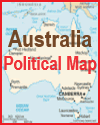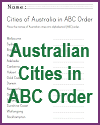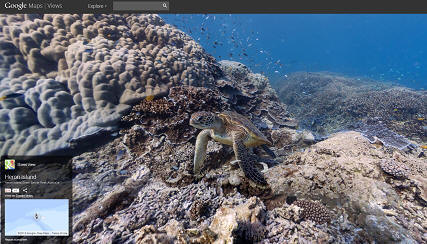| Geography of Australia |
| www.studenthandouts.com > World Geography > Oceania > Australia |
 |
 |
 |
 |
 |
||||||
| Australian Flag | Australia Political Map | Australia Handwriting Worksheets | Australia Global Position Map | Australian Sheep Farm, circa 1920 |
 |
 |
 |
||||||||
| Australia Word Search Puzzle | Australian Cities in ABC Order | Australia Map Worksheet |
 Google Maps Street View makes it possible to tour the floors of several of the world's oceans. Google Maps Street View makes it possible to tour the floors of several of the world's oceans.The image to the left was taken from here and features the waters off of Heron Island, Great Barrier Reef, Australia. Students will love the 360-degree views of this and other deep sea habitats. Click here for the main page of Google Street View Oceans. |
|
Australia is a crucial component of a World Geography course for several important reasons.
Geographical Diversity: Australia is the world's sixth-largest country, and it boasts a wide range of geographical features and landscapes. Students can study the continent's deserts, rainforests, mountains, coastlines, and the vast Outback. Understanding this diversity helps students appreciate the complexity of Earth's physical geography. Unique Ecosystems: Australia is known for its unique and often endemic ecosystems, including the Great Barrier Reef, one of the world's most extensive coral reef systems. Studying this country provides opportunities to explore biodiversity and the importance of conservation. Climate Variability: Australia experiences diverse climatic conditions, from tropical in the north to temperate in the south and arid in the interior. Learning about these climate zones helps students understand the factors that influence weather and climate patterns globally. Cultural and Indigenous Perspectives: Australia's history includes both Indigenous cultures that have existed for tens of thousands of years and European colonization. Students can examine the impact of colonization on Indigenous populations and their unique cultural contributions. Economic Significance: Australia is a significant player in the global economy, particularly in terms of its natural resource exports (e.g., minerals, agriculture). Understanding Australia's role in international trade and economics is valuable in a global context. Political and Regional Context: Australia's geopolitical position in the Asia-Pacific region is strategically important. Its alliances, trade relationships, and regional dynamics are essential for understanding global politics and security. Urbanization and Migration: The majority of Australia's population lives in urban areas, and the country has a history of immigration. Studying Australian cities and migration patterns provides insights into global urbanization trends and multicultural societies. Environmental Challenges: Australia faces various environmental challenges, including issues related to water scarcity, land degradation, and wildfires. These challenges can be used to illustrate broader global environmental concerns. Time Zones and International Date Line: Australia spans multiple time zones and is affected by the International Date Line. Learning about these geographical concepts helps students understand how time and geography are interconnected. Case Studies in Geography: Australia serves as a valuable case study for various geographical concepts, such as landforms, climate, vegetation zones, and natural hazards. These case studies can enhance students' understanding of geography principles. Tourism and Recreation: Australia is a popular tourist destination with iconic landmarks like Uluru, the Sydney Opera House, and the Great Ocean Road. Studying tourism in Australia provides insights into the global tourism industry. Global Connectivity: Australia's connectivity with the rest of the world through trade, travel, and digital communications highlights its place in the global network of countries. Environmental Sustainability: Australia's experiences with environmental sustainability, including conservation efforts and responses to climate change, are relevant to broader discussions on global sustainability. Incorporating Australia into a World Geography course offers students a rich and diverse range of topics to explore within the context of a single country. It provides opportunities for interdisciplinary learning, linking geography with history, culture, economics, environmental science, and international relations. Ultimately, studying Australia enhances students' global awareness and their ability to analyze and appreciate the interconnectedness of the world's geography. |
| www.studenthandouts.com > World Geography > Oceania > Australia |






